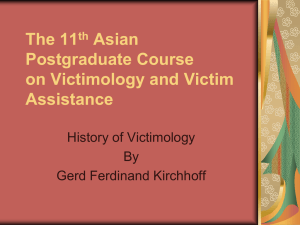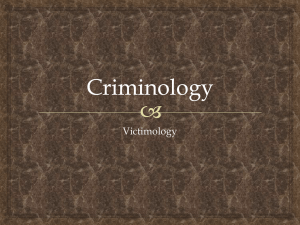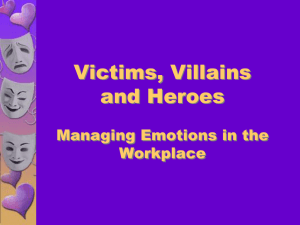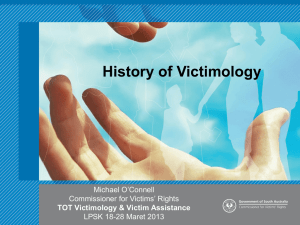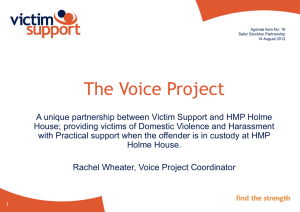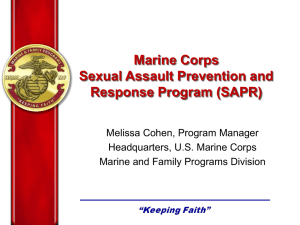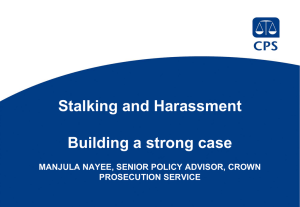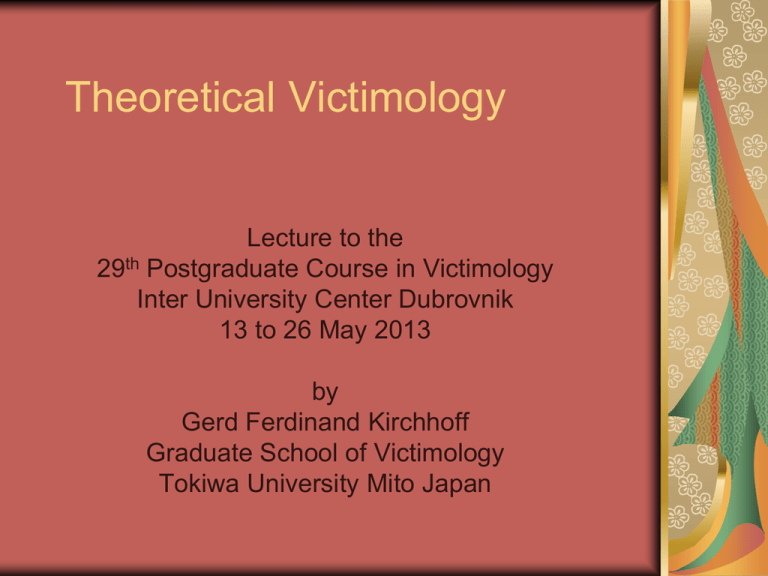
Theoretical Victimology
Lecture to the
29th Postgraduate Course in Victimology
Inter University Center Dubrovnik
13 to 26 May 2013
by
Gerd Ferdinand Kirchhoff
Graduate School of Victimology
Tokiwa University Mito Japan
Victimology
implies something theoretical that fifty years ago
plainly did not exist. Fourty years ago, it was seen
as a
“hodgepodge of ideas, interests, ideologies and research
methods that have been rather arbitrarily grouped
(Cressey 1979 and 1985)
Fattah 2000
Distinguishes between
“humanistic victimology” (represented by the victim
assistance community)
“scientific victimology” which for him was part of
criminology
Territorial dug in war
Why did the criminologists have these difficulties in
accepting victimology as an independent new science?
The fight for recognition of criminology as a distinct science
interest driven:
a competitor on the fight for grants must be controlled
criminology qua criminology did nothing for the victims
in the past, victim ideas have been pretty much connected with
social democratic ideas
Lombroso
Ferri, Garofalo
that did not fit into a subconsciously capitalistic
criminology which had its own struggles to be
accepted
Sutherland and Chicago School
“victim identity” thinking of criminologists – not a
good term!
Two new things happen:
1. Hans von Hentig introduces into criminology a clearly
interactionalist element: the interaction between doer and
sufferer - clearly in the interest of social control and of
improving criminology
The new perspective does not have an own territory
Followers of von Hentig like Schafer place victimology
clearly in the field of criminology
Wolfgang was never explicitly decided but favored a look to
victim issues
“Special Victimology”
There were no chairs, no grants, and there was no future in
this field -> criminology had occupied the seats and the key
position
2. Mendelsohn “General victimology”.
Mendelsohn’s (mostly) formal
ingredients”” of a science
all victims
an international society of victimology
clearly a scientific organization
– the new kid on the block”
» concerns of criminologists
» concerns of sociologists
» concerns of practitioners
» 1976 Foundation of NOVA and 1979 Victim
Support UK
» victims are our property!
Development of two fields
Theoretical Victimology
Admittedly very conservative and
cautious
Field of Victim Assistance
Very dynamic, full of enthusiasm,
passionate claim for victims and against
the neglect of victims in the criminal
justice system
A highly interesting social movement,
Under the header “victims” strange
bedfellows meet!
1985 Hans von Hentig Award to
Marlene Young
bridge between victimology and victim
assistance, especially demanded by the
influential American EC members who
were personal friends of Marlene
difficult to maintain the separation between
victim assistance and victimology
– in victimology, victim assistance is included
– consequences
– sympathy between practitioners and scientists
1985 very successful
UN Declaration on Basic Principles of Justice
for Victims of Crime and Abuse of Power
(created from within WSV by Irvin Waller and
LeRoy Lamborn in connection with Irene Mellup
from the UN.
Takeover and implementation of victim
orientation in a criminal justice system by
(South Australia, Labor) Chris Sumner
continued by followers, now the first Victim
Commissioner Michael O’Connell
l
Elections to the EC reflected the
stand-offish attitude of scientists and
the willingness of activists to move
the cause internationally
extreme skilled leadership in USA, UK
and Mexico
Peak of influence of activists in 2006
“Enhancing the Mission”
Mendelsohn 2
International Symposia
1973 Drapkin-Viano 6 readers
1976 Boston no reader
1979 Muenster 2 readers and 1 book in German
1982 Tokyo 1 reader
1985 Zagreb 1book, two readers
1988 Jerusalem 1 reader
1991 Brazil 4 readers, 1 book series
1994 Adelaide 1 reader
1997 Amsterdam 1 reader
2000 Montreal 1 reader
2003 Stellenbosch 1 reader in print
2006 Orlando 1 reader
2009 Mito 1 reader
2012 Den Haag 1 reader
Mendelsohn 3
Institutes of Victimology
(1968 - 1992 Koichi Miyazawa’s institute in
Keio, Tokyo, Japan)
Bellagio Institute 1975 (Emilio Viano)
1998 Sarajevo (WSV and University of
Sarajevo, dormant)
2003 Tokiwa University (Hidemichi Morosawa,
John Dussich)
2004 Intervict in University of Tilburg
(Groenhuijsen, van Dijk, Winkel)
Today many institutes (WSV website)
Mendelsohn 4
Journal of Victimology
1976 Emilio Viano’s “Victimology - an
international journal”
NOVA’s Newsletter, WSV Newsletter 1982,
The Victimologist
International Review of Victimology UK
International Perspectives of Victimology
(Tokiwa) since 2004
numerous other special journals
Formal requirement 5
Textbooks
numerous textbooks, the first in 1975
Schneider (in German language)
mainly English language textbooks
market situation a clear advantage
tailored to the need of the teaching and
learning and refined by competition
driven by the growing market in victim
assistance
an abundance of monographs
Friday 2000 talks about “globalization” in
victimology -
That has clear advantages
Many excellent and very often very useful
empirical contributions
triggered by the success of the National US
Crime Victim Surveys and the International
Crime Victim Survey gave a method to
measure victimizing incidents
independently from crime statistics
There is a wealth of empirical data, articles
and monographs
Development of academic teaching
All the efforts would be in vain if victimology did not enter the
classrooms of the university
Regular teaching in victimology started in sociology
seminars, in criminology classes in the seventies.
In the same time regular classes were held usually after the
Bellagio Institute 1975 by participants
1984 the first Postgraduate Course on Victimology convened
in Dubrovnik, Croatia - till now 29 conferences of this course
1985 the first panel “Young Victimologists” in Zagreb with
students
1994 in Adelaide, Hauber, Kirchhoff and O’Connell
convened workshop on “Teaching Victimology” (basically
three curricular and critique of them) overcrowded
2000 Teaching Victimology : 80 participants demanded from
WSV to develop a curriciences (culum. No doubt, victimology
had entered the classrooms
2003Tokiwa University Mito Master in Victimology
2003 PhD in Human Sciences Subfield Victimology
2012 Tilburg University Master in Victimology and Criminal
Justice
2013 PhD Victimology Tokiwa University
Fattah 1998
All in all,
victimology is no longer a subject of
bewilderment or curiosity but is slowly
becoming a household name. This is being
facilitated by the extensive coverage that crime
news and victim issues are receiving in the
mass media; by the wide publicity victims’
programs are getting and by the
proliferation of victim services and victim
assistance programs in many countries
(Fattah:
http://www.unafei.or.jp/english/pdf/PDF_rms/no56/56-06.pdf
retrieved on May 3, 2007).
Courses are given in tandem with the symposia
(Rio 1991, Amsterdam 1997, Montreal 2000, Stellenbosch 2003,
Orlando 2006, Mito 2009) - independent from WSV by Fattah and
Peters Courses in the Canaries
Numerous universities have lectures and seminars in victimology
Numerous professional courses and training academies developed
for practitioners in victim assistance
the need to train volunteers
excellent training material in USA, UK, New Zealand, Australia,
Canada
from 1995 on the National Victim Assistance Academy funded by
the Office of Crime Victims, Office of Justice Program, US
Department of Justice
Special faculties for the study and practice of Traumatic Stress
Studies - e.g. University of Charleston, South Carolina
South America: Hilda Marchiori, Elias Neuman, Manzanera and
others in INACIPE Mexico with the first master degree constituted
Problem of finding a “home faculty” for a
study that draws from sociology,
psychology, medicine, social work, political
science, criminology and law, especially
criminal law and criminal procedure.
Integrating knowledge from so many
faculties, the field has no own single
unifying theory
This is a reason that it is not regarded as a
science - but it behaves like a science.
and it is more an more accepted as such.
Master Study in Victimology e.g.
in Tokiwa University Japan
In Tilburg University Netherlands
Doctor Programs e.g.
in Tokiwa University
In Tilburg University
Fattah on Victimology
Fattah: the primary task of theoretical
victimology is to collect empirical data on
crime victims. This is done by victim
surveys. It is not yet clear what these
surveys measure. Are the surveys
designed to measure crime or
victimization? Are they meant to measure
criminal victimizations that meet the criteria
set by the criminal code? or are they meant
to measure subjective victimizations
experienced by the respondents. These
are different realities.
Fattah on Victimology
From here, he unfolds the different theoretical
models that have led to various theoretical
formulations:
- Lifestyle Model
a simple and logical extension of the medical concept into
the social sphere: smoking, sedentary way of life, aids and
eating increase health risks.
Routine Activity Approach
Opportunity Models
L and RA brings potential victims together with motivated
offenders (proximity, attractiveness and exposure) or
direct differential opportunities.
This is the model that Fattah favors:
Fattah then describes a flurry of victim legislation,
victim compensation, offender restitution and
victim services.
Information from the sociology of
social movements
Scientists form an interest group (Berger and Luckmann
1986). They are interest driven.
interests are formed by invested “capital”
by scientific convictions certainly,
by interest in being funded
by an interest of being acknowledged by peers and students
and “followers”
Theories - the special tools in the competition and identity
markets - are validated more by social support than by
empirical evidence.
The intensity of support determines the ultimate success of this
interest group - like any other interest group - in their efforts to
promote a cause, a problem, a science.
Scientific theories in any field of science are a kind of social
construction of reality. This is not different in social science,
here: in victimology.
Positivist, radical or critical versions of victimology (identified
by Mawby and Walklate 1994) are just different competing
constructions in victimology.
Individuals and interest groups construct and generate social
problems out of their interests, whether there are data in
objective reality that justify this or not.
Data can be produced ad libidum and ad nauseam!
That does not change the fact that scientists are interest
driven.
Special knowledge is formulated and administered by
specialists whose social prestiges depend on their special
ability to teach, to write, to do research, to distribute
resources, occupy the media.
To avoid their dictatorship, it is needed to keep the
connection to victim assistance.
Maus (1975) developed a convincing model that explains
how society in general reacts towards the “new kids on the
block”
Victimology was received by the relevant existing groups the publics in criminal law, criminology, social sciences
generally and by the stakeholders in the status quo - exactly
in the same way society deals with new social movements.
Techniques include
overlooking
rejection
ridicule “feel free to call it victimology!”
outright fanatic opposition
attacks
cooptation
that is nothing new
we embrace the efforts fully
recognition
This recognition is dangerous:
only if there is enough disquieting noise and unrest, the
stakeholders of the traditional way of thinking (or the existing
social order) will listen and finally will react.
These reactions are applauded by the outer circle and often by
the inner circle as well. Then the problem is solved.
Dangerous moment: The resounding body is leaving the
movement and turns to other goals (e.g. crime prevention,
restorative justice or transformative justice) the inner circle of
“true believers” “the activists” “the hard core” is still
dissatisfied and continues the fight.
Observations:
1985 UN Declaration
There are many examples
Nils Christie brought a practical development in
victim offender mediation to the theoretical
point: horizontal or vertical justice? The
systems often adopted horizontal elements.
Participation of victims:
full fledged participation
or fake participation:
–
–
–
–
in Japan very new reform
victim impact statements
mediation, victim offender reconciliation
victim assistance organizations:
» in Germany it is very difficult to introduce new
measures “for victims” that are not supported by
the greatest victim organization Weisser Ring.
Observations on theoretical
victimology
Victimology is the social science of victims, of
victimizations and of the reactions toward both,
towards victimization and towards victims.
Is victimology the same as the contributions of
other science towards victimology?
especially in the first period of academic teaching, the
field depends on scientists from various other disciplines
who lecture about the contributions of their home
faculties to the emerging field.
Is victimology more than the sum of contributions of other
sciences?
Structure of Victimology
1. Social Science of Victims
Who are the victims in victimology?
3 kinds of victims have been discussed
Victims of crime
Victims of “everything”
Victims of Human Rights violations including
crime
The measurement of victims
Of course we want to know “how many are out
there?”
›
›
›
Victim Survey
A general question:
From what do we know how many crimes are “out
there”?
›
Police statistics
Self reports of actors
Self reports of victims
These systematically collected self reports are called Victim
Surveys.
Big advantage:
We can ask other things,
What goes hand in hand with victimization?
30
Often sociologists find that victimization
goes hand in hand with the same kind
of variables crime goes hand in hand
with
›
The social correlates of crime
E.g. Routine activity theory
Routine activities bring people differently in
contact with offenders
Motivated offenders
Attractive target
Lack of effective guardian
» That is criminology: it explains under what
conditions crime happens very probably
31
Victims have experienced
damage
I did not want to talk about crimes but
about victims.
Typical for the victim is:
They have experienced a damage
An emotional damage
A physical damage
A financial damage
– Social damage? Damage in reputation? Is this an own
category? Where does this belong?
That is very important to keep in mind: this triangle
describes a victim very well. For analytical
purposes we have to keep these dimensions apart:
32
Social Science
of Victims
of Victimizations
Two perceptions of victimization
1. the static one
2. a more dynamic one
Victimizations
Victimology is the social science of
1. victims
2. of victimizations
2.1. as a process
2.2 the damage the victim has
experienced
2.3. the process of becoming a victim:
victimizations as invasions into the self
Victimization as a process
The next concept:victimizations.
Victimization means a process: the process of
becoming a victim.
sometimes very short
sometimes long and escalating
it is a social process of becoming a
victim
social definitions that prepare the
victim for its demise: e.g. victims of
genocide
36
Victimization
The static model
The three dimensions of damage
– Emotional damage (including social damage)
– Physical damage
– Financial damage
Useful for analytical purposes
A little bit simple
We know that it is “artificial”
The dynamic model
37
Definition of a victimization as
process
Victimizations are
Invasions into the Self of the Victim
In this definition, we see
a certain model of a person
There is a self, which can be invaded
(Painting)
Invasion means a certain penetration from
outside
there is something around the “self”
There is a kernel
That we are going to explore a little bit more
in detail
2015/4/13
Prof. Dr.jur. Gerd Ferdinand
Kirchhoff
38
The Self … and the layers
Imagine an onion
Here is the outer peel
Brown and tough
Remove it: you come to more tender parts
–
–
–
–
–
–
Parts which never have seen the sun
Parts which are softer
The deeper you go, the softer is the material
The softer, the more sensitive to intrusions
The more sensitive, the easier it is to intrude
The less protected, the more pain is produced by
intrusions
– In the center of the onion, there is the real Self
2015/4/13
Prof. Dr.jur. Gerd Ferdinand
Kirchhoff
39
The self and the layers
Victimizations are Invasions into the
Self of the Victim
›
You win a feeling for a rank order of
victimizations
›
According to their severity
Severity is represented by the deepness of the
invasion into this model
Victimizations on the surface are light and
easy
2015/4/13
Intensity 1rst degree
Loss of non valuable cheap mass products
Different: emotionally loaden items
Prof. Dr.jur. Gerd Ferdinand
Kirchhoff
40
Intensity 2nd degree
The case of theft of an inherited ring
of mother
The case of burglary
›
Feeling of invasion of privacy
› Feeling of shattered security
› Feeling of loss of property
Reactions:
Fear, Panic attacks
Sleeplessness
Headache
2015/4/13
Prof. Dr.jur. Gerd Ferdinand
Kirchhoff
41
Invasions: Intensity 3rd degree
Imagine Street Robbery
›
First you do not believe what happens
›
›
›
›
›
›
›
This is a joke!
Then: panic, anger, nervousness
Rage that nobody comes and helps
Loss of ability to evaluate social situations
properly
Loss of physical integrity
Loss of property
Sadness that nothing is like it was before
Insecurity!
2015/4/13
Prof. Dr.jur. Gerd Ferdinand
Kirchhoff
42
Intensity 4rth degree
Sexual victimization
›
In human interactions, everyone sends
and receives signals of sexual content
This happens all the time
But:
we believe that is only so
in moments where we want this to happen
In moments where we are aware of this
›
Sex offenders grab us exactly at this
spot of our personality
2015/4/13
Prof. Dr.jur. Gerd Ferdinand
Kirchhoff
43
Intensity fourth degree
Sexual Victimization
›
Destruction of identity
You lived protected in yourself
Now you feel open to the grabbing invasions of everybody
You feel unprotected
You feel insecure and you panic
You thought you could determine yourself what happens
with you
Now you feel that you are powerless
You have no autonomy
You felt you were a person with its own dignity and worth
Now you feel invaded by someone who wears dirty shoes and
who has muddy hands
Your self esteem is destroyed
2015/4/13
Prof. Dr.jur. Gerd Ferdinand
Kirchhoff
44
Can you live with such a feeling
about you and your life?
›
›
›
›
›
No
Life-preserving fictions are destroyed
These fictions are like a shield around
you
Now you are forced to live without the
protection of these believes
This is completely unknown to you
You feel naked among wolves!
2015/4/13
Prof. Dr.jur. Gerd Ferdinand
Kirchhoff
45
Victimizations
Victimology is the social science
1. of victims
2. of victimizations
2.1. the damage the victim has experienced
2.2. the process of becoming a victim:
victimizations as invasions into the self
3. and of reactions towards both
3.1 informal reactions of the victim : crisis and
crisis reactions
3.2 informal reactions of the social environment
3.3.1 secondary victimization
3.3.2 crises and intervention
Invasions cause Crisis
These invasions cause crisis
›
Crisis is an escalating feeling of insecurity
› It is triggered by the experience
That the normally available powers to handle insecurities
are blocked
They do not function
They are gone
You are frozen
›
This experience makes the fear bigger
› In an escalating spiral this feeling becomes
unbearable
› It explodes into a reaction
2015/4/13
Prof. Dr.jur. Gerd Ferdinand
Kirchhoff
47
Crisis Reactions
Reactions can be
›
Very silent
›
Sadness - Depressions - Mood Disorders
It closes your mouth - You say nothing
Very dramatic
Very expressive
Very loud
Crying and uncontrolled reactions
Immediately ….. or delayed
› Culturally determined
›
2015/4/13
Prof. Dr.jur. Gerd Ferdinand
Kirchhoff
48
Helplessness
Feeling of chaos and being without orientation
Rage and anger
›
that this happened to me
› that no one helped me
Disappointment about family
Isn’t he supposed to protect me?
› Why did they leave me alone in such a decisive
moment ?
›
Anger about the offender
›
That he was so unashamed to treat me like this!
2015/4/13
Prof. Dr.jur. Gerd Ferdinand
Kirchhoff
49
I will never be able to feel safe again!
I can trust nobody
›
In the decisive moment, they disappear
I feel guilty
›
›
›
If I had not behaved like this…..
My contributive behavior (behavior attribution)
This is me, my character (character attribution)
I feel ashamed
›
›
My value is damaged
What will the family say about me? What will
the friends say? My colleagues?
2015/4/13
Prof. Dr.jur. Gerd Ferdinand
Kirchhoff
50
Crisis is so escalating that it calls for an
end
People cannot life in crisis
We are reliant to live in a meaningful world
We cannot live without meaning
›
›
Dangerous:
Victim can often not find out of this situation
without damaging himself
2015/4/13
Suicide, despair, mental breakdown
Retreatism: no contact, loneliness, feeling to get crazy
Self blame
Prof. Dr.jur. Gerd Ferdinand
Kirchhoff
51
REPEAT VICTIMIZATION
ONE TIME VICTIMIZATION
›
Imagine that this all happens after the first time
REPEAT VICTIMIZATION
›
›
means that victims get victimized more than once
By the same kind of victimization
If you are victimized a second time but by another kind
of victimization, we call this MULTIPLE VICTIMIZATION
Once you shift your attention to multiple victimization,
you find that very many victimizations are repeat
victimizations
2015/4/13
Burglary
Child beating
Domestic violence
Sexual exploitation
Labor exploitation
Prof. Dr.jur. Gerd Ferdinand
Kirchhoff
52
Victimizations
Victimology is the social science
1. of victims
2. of victimizations
2.1. the damage the victim has experienced
2.2. the process of becoming a victim:
victimizations as invasions into the self
3. of reactions towards both
3.1 reactions of the victim: crisis and crisis
reactions
3.2 reactions of the social environment
Secondary Victimizations
Damaging reactions of the immediate or wider
social environment
Immediate: parents, siblings, husbands, wifes, children
Wider: neighborhood, colleagues in the workplace,
schoolmates, teachers,
Institutions and those working in them: policemen,
nurses, physicians, telephone crisis volunteers, victim
assistance workers, therapists and physicians
Secondary victimization makes us especially angry if it
happens by people who officially are said to exist to help
the victim.
Avoidance of secondary victimization is the first aim in
victim assistance - an important and very rewarding
field.
What to do now?
Crisis Intervention
›
Someone from outside steps in between
› And tries to interrupt the fruitless self
dialog within the victim
› By being together with the victim
› By communicating with the victim
2015/4/13
Verbally
Non verbally
Prof. Dr.jur. Gerd Ferdinand
Kirchhoff
55
Crisis Intervention
1. Listening,
›
Listening
Listening
Listening
Listening
Victims have to express their emotions
They do this often very intense
They do it over and over again
They are like crying people
crying people can not listen to what is said
therefore:
listen, do not talk, except communicate: you
are not alone!
2015/4/13
Prof. Dr.jur. Gerd Ferdinand
Kirchhoff
56
Crisis Intervention 2
2.
Work on the emotional stabilization of the
victim
›
›
›
Principle: you are not alone
Principle: you are safe now…..
Let the victim get more calm
That goes often hand in hand with telling
Telling means:
to put something outside
To be able to listen to it
To be able to look at it
2015/4/13
Prof. Dr.jur. Gerd Ferdinand
Kirchhoff
57
Crisis Intervention 3
›
What has to be done now?
Let the victim find out alternatives what to do
Assist in stock taking
Do not judge
Do not direct
Do not order
It is the VICTIM who has to go the next steps
Not you!
Victim empowerment
Exploring the alternatives
2015/4/13
Prof. Dr.jur. Gerd Ferdinand
Kirchhoff
58
Crisis Intervention 4
3. Victim decides what to do
›
You help victim to see the
›
Disadvantages
Advantages
Of each decision
And you reinforce the victim in what the
victim decides
Safety planning
Limit: Suicide, killing someone
2015/4/13
Prof. Dr.jur. Gerd Ferdinand
Kirchhoff
59
Crisis Intervention 5
4.
Help and Support in going through
›
›
›
›
›
›
Crisis interventionalist knows the system
very well
Victim has never interacted with the system
It needs advice
It needs support
It needs company
It needs encouragement
2015/4/13
Prof. Dr.jur. Gerd Ferdinand
Kirchhoff
60
Typical Standards
You are safe now!
You are not alone
You did nothing wrong.
You do not have the responsibility
for what happened to you. You are
not to be blamed.
You can do it, you are important
2015/4/13
Prof. Dr.jur. Gerd Ferdinand
Kirchhoff
61
You are not alone
›
›
›
›
›
›
Someone is with you
Someone cares
There is no isolation
I know you feel lonely but here is an
offer to communicate
I will be company
I have no other agenda
2015/4/13
Prof. Dr.jur. Gerd Ferdinand
Kirchhoff
62
You are safe now!
›
›
›
›
›
This is a room where the offender cannot
reach you.
This is a room where you can relax
Your fears were justified but now you can
let them go
Do you feel safe? What can I do to make
you feel safe as long as you are here?
Whom do we need to ask for protection?
2015/4/13
Prof. Dr.jur. Gerd Ferdinand
Kirchhoff
63
You did nothing wrong
›
Victim Assistance is to help the victim
cope with the consequences of the
victimization
It is not the aim to find out who is to be
blamed what has happened
Especially not the victim!
You have been wronged! No one is allowed to
treat you the way you were treated
This is indeed wrong what happened to you.
You feel the right way ….
2015/4/13
Prof. Dr.jur. Gerd Ferdinand
Kirchhoff
64
This is not your fault
The offender is responsible
You did not decide that this should
happen to you
It was the decision of the offender
Not you are responsible for this
decision
›
Be aware of the need to distinguish:
2015/4/13
Responsibility for this event
Responsibility for future prevention
Prof. Dr.jur. Gerd Ferdinand
Kirchhoff
65
These principles are derived from what practitioners of
victim assistance share, write and teach in trainings of
volunteers.
Of course these principles are highly contested among
experts.
Often the experts do not talk about the usual
disturbances and crises victims go through, they talk
about the few victims who are severely damaged.
What is still missing, is a scale for the severity of
victimization. Of course that has to do with the
multiplicity of damage dimensions.
Since we do not have clear measurements for the
severity, we do not know what is the success of all
attempts to alleviate the burden for victims.
Interesting Research Fields
Psycho-traumatologists tell us that PTSD can be
prevented if they can start early with the treatment.
Develop a scale that separates the big risks from
the small risks and work with the big risks.
The traditional methods of victim Assistance do
not work.
Cui bono? Who has the profit of all the suggested
reforms in Criminal Justice?
What is the benefit for victims? Often ideology and
victim work make it difficult to find out whether the
victim profits or the group that promotes the
ideology behind the program. Especially nice in
criminal justice programs.
Structure of victimology
Victimology is the social science of
1. victims
2. of victimizations
3. of reactions towards both
3.1 who reacts?
3.2 informal and formal reactions
Reactions
1. who reacts?
1.1victims
1.2 the social environment
2. what effects do reactions have?
2.1 Damaging reactions: secondary
victimization
2.2 Helpful reactions: victim assistance
programs
2.3 unconcerned reactions ? The reactions
of the criminal justice system
Reactions
2. What kind of reactions?
2.1 Informal reactions
2.2 Formal reactions (written down,
formalized)
2.2.1 Traditional criminal justice reaction
The victim in the criminal justice system
The role of the victim in criminal
proceedings
2.2.2 More recent developments which have
been extensive introduced by previous
speakers. As far as these developments have
the victim in the center of their endeavors, they
are part of victimological studies.


